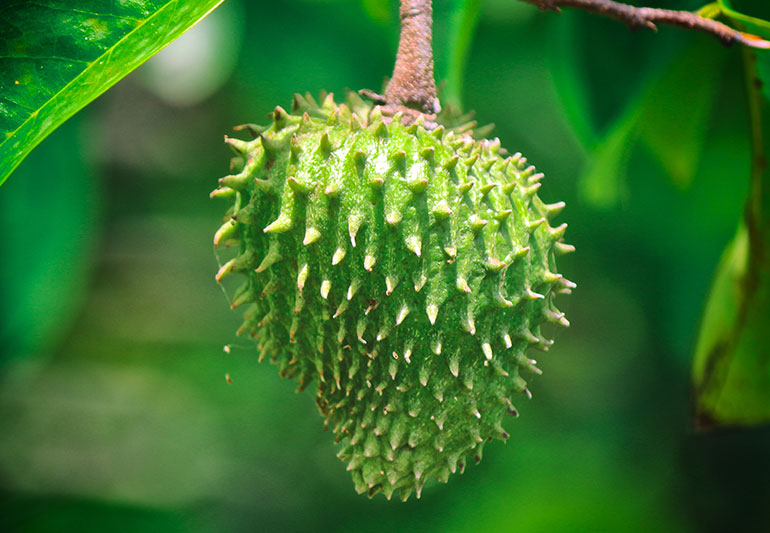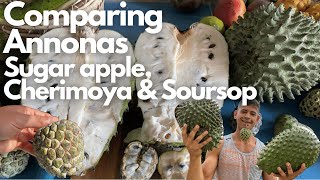Introduction

Soursop and custard apple are two tropical fruits that are often compared due to their similar appearance and taste. While they may share some similarities, there are distinct differences between the two fruits that make each unique. This article aims to provide a comprehensive comparison of soursop and custard apple, highlighting their health benefits, culinary uses, nutritional value, taste profiles, and overall appearance. By understanding the key differences and similarities, readers can decide which fruit suits their taste preferences better and explore new options to add variety and nutrition to their diet. So, let’s dive into the tropical fruit face-off between soursop and custard apple!
A Brief Overview Of Soursop And Custard Apple
Soursop and custard apple are both tropical fruits known for their unique flavors and health benefits.
Soursop, also known as graviola, is a green fruit with a spiky outer skin. It is known for its creamy, white flesh and sweet, tangy flavor. Soursop is rich in vitamins, minerals, and antioxidants, making it a nutritious addition to any diet. It is also believed to have potential health benefits, including immune-boosting, anti-inflammatory, and anticancer properties.
Custard apple, also known as sugar apple, is a round fruit with a bumpy green skin. It has a creamy, custard-like flesh with a sweet and slightly tangy flavor. Custard apple is a good source of vitamins and minerals, including vitamin C and potassium. It is also known for its high fiber content, which promotes digestive health.
Both fruits offer unique tastes and textures that can be enjoyed in various culinary preparations.
Soursop
Soursop, also known as graviola, is a tropical fruit with a green, spiky outer skin and creamy, white flesh. It is renowned for its sweet and tangy flavor, often compared to a combination of mango and pineapple. Soursop is not only delicious but also packed with essential vitamins, minerals, and antioxidants, making it a healthy choice. It is believed to possess numerous health benefits, including boosting the immune system and reducing inflammation. Additionally, soursop has been studied for its potential anticancer properties. Whether enjoyed fresh, in juices, or incorporated into various culinary creations, soursop is a delightful and nutritious fruit to add to your diet.
Soursop Health Benefits

Soursop, also known as graviola, offers a wide range of health benefits. This tropical fruit is rich in vitamins and antioxidants, which can support a healthy immune system and promote overall well-being. Research suggests that soursop may have anti-inflammatory properties, making it helpful in reducing inflammation and alleviating pain. Additionally, soursop contains compounds that have been studied for their potential anti-cancer properties, although more research is needed in this area. Furthermore, soursop can aid in digestion and may help lower blood pressure. Incorporating soursop into your diet can be a delicious and nutritious way to support your health.
Soursop Culinary Uses
Soursop is a versatile fruit that is commonly used in various culinary creations. Its creamy and tangy flavor makes it a popular ingredient in beverages, including refreshing juices and smoothies. Soursop is also often used to make delicious ice creams and sorbets, adding a tropical twist to these desserts. Additionally, soursop can be incorporated into savory dishes, such as salads, salsas, and marinades. Its unique flavor profile and creamy texture make it a versatile ingredient that adds a delightful touch to any recipe. Whether you enjoy it in a beverage, dessert, or savory dish, soursop is sure to satisfy your taste buds.
Custard Apple
Custard Apple, also known as sugar apple or sweetsop, is a tropical fruit with a unique flavor and creamy texture. This fruit is native to South America and is now grown in various parts of the world, including Asia, Africa, and the Caribbean.
Custard Apple is known for its sweet and aromatic taste, resembling a mix of vanilla, banana, and pineapple. Its creamy flesh has a custard-like consistency, which gives the fruit its name. The fruit is rich in essential vitamins and minerals, including vitamin C, vitamin B6, potassium, and magnesium.
Custard Apple is commonly eaten fresh, scooped out of its skin and seeds. It can also be used in various culinary creations, such as smoothies, desserts, and ice creams. With its delightful flavor and creamy texture, Custard Apple is a delicious addition to any tropical fruit selection.
Custard Apple Nutritional Value

Custard Apple is a nutritious tropical fruit that is packed with essential vitamins and minerals. It is a good source of vitamin C, which helps boost the immune system and promote healthy skin. Custard Apple also contains vitamin B6, which is important for brain function and the production of red blood cells. This fruit is rich in potassium, which helps regulate blood pressure and maintain proper heart function. Additionally, Custard Apple is a good source of magnesium, a mineral that is necessary for a wide range of bodily functions. Including Custard Apple in your diet can provide you with a variety of important nutrients for overall health and well-being.
Custard Apple Taste Profile
Custard Apple, also known as sugar apple, has a distinctive and delightful taste profile. Its flavor can be described as a combination of sweet and creamy, with hints of vanilla and tropical notes. The creamy flesh of the fruit melts in your mouth, reminiscent of a smooth custard dessert. The sweetness of the Custard Apple is not overpowering, making it a pleasant treat for those who prefer milder flavors. Its texture is soft and velvety, making each bite a delight. The sweet and creamy taste of Custard Apple makes it a popular ingredient in desserts, smoothies, and ice creams. It is a true tropical delight for your taste buds.
Soursop Vs Custard Apple: Appearance
When comparing the appearance of soursop and custard apple, there are notable differences. Soursop, also known as guanabana, has a unique and distinct look. It features a spiky green rind with a soft and white pulp inside. The fruit can grow quite large, with some reaching up to 12 inches in length and weighing several pounds.
On the other hand, custard apple has a more compact and rounded shape. Its exterior is characterized by a brownish-green skin, which is rougher compared to the smooth skin of soursop. When cut open, custard apple reveals a luscious and creamy flesh that can be either white or reddish.
Both fruits have their own visual appeal, enticing consumers with their vibrant colors and intriguing textures.
Comparison Of Appearance Between Soursop And Custard Apple

When comparing the appearance of soursop and custard apple, there are notable differences. Soursop, also known as guanabana, has a unique and distinct look. It features a spiky green rind with a soft and white pulp inside. The fruit can grow quite large, with some reaching up to 12 inches in length and weighing several pounds.
On the other hand, custard apple has a more compact and rounded shape. Its exterior is characterized by a brownish-green skin, which is rougher compared to the smooth skin of soursop. When cut open, custard apple reveals a luscious and creamy flesh that can be either white or reddish.
Both fruits have their own visual appeal, enticing consumers with their vibrant colors and intriguing textures.
Soursop Vs Custard Apple: Flavor And Texture
When it comes to flavor and texture, soursop and custard apple offer distinct experiences for your taste buds. Soursop is known for its unique sweet and sour flavor, which has been described as a delightful combination of mango and pineapple. The flesh of soursop is fibrous and somewhat grainy, giving it a satisfyingly textured bite.
On the other hand, custard apple boasts a sweeter taste, reminiscent of a creamy custard. The flesh of custard apple is smooth and velvety, almost like spooning into a delectable dessert.
So, whether you prefer the tangy nuances of soursop or the smooth sweetness of custard apple, both fruits provide a tantalizing burst of flavor and an enjoyable texture that will surely satisfy your palate.
Contrasting Flavors And Textures Of Soursop And Custard Apple
Soursop and custard apple offer distinct flavors and textures that make them unique tropical fruits. Soursop has a delightful combination of sweet and sour flavors, reminiscent of mango and pineapple. Its flesh is fibrous and slightly grainy, providing a satisfying texture with every bite.
On the other hand, custard apple boasts a sweeter taste, resembling a creamy custard. Its flesh is smooth and velvety, creating a delectable melt-in-your-mouth experience.
So, whether you crave the tangy nuances of soursop or prefer the smooth sweetness of custard apple, both fruits provide a tantalizing burst of flavor and an enjoyable texture. They are sure to satisfy your palate and add a unique twist to your fruit selection.
Conclusion

In conclusion, soursop and custard apple are two tropical fruits that may appear similar but offer distinct flavors and textures. Soursop delights with its sweet and tangy taste, while custard apple is known for its creamy and sweet flavor. Both fruits provide unique culinary experiences and are packed with nutrients. Whether you prefer the refreshing and fibrous texture of soursop or the smooth and velvety texture of custard apple, both fruits offer a delightful addition to your fruit selection. So, indulge in these tropical treats and enjoy the burst of flavors they have to offer.
Key Differences And Similarities Between Soursop And Custard Apple
Soursop and custard apple, while similar in appearance and taste, do have some key differences and similarities.
Differences: Soursop has a tangy and slightly acidic taste, while custard apple has a creamy and sweet flavor. In terms of texture, soursop is fibrous and refreshing, while custard apple is smooth and velvety.
Similarities: Both fruits are rich in nutrients such as Vitamin C and dietary fiber, making them healthy choices. They also provide a tropical flavor experience that is unique and enjoyable.
Overall, while soursop and custard apple offer distinct culinary experiences, they are both delicious and nutritious options for fruit lovers.
Which Fruit Suits Your Taste Preferences Better?
When it comes to choosing between soursop and custard apple, it ultimately boils down to personal taste preferences. If you enjoy tangy and slightly acidic flavors, then soursop may be the fruit for you. Its refreshing and fibrous texture adds to its unique appeal. On the other hand, if you have a sweet tooth and prefer creamy and velvety flavors, custard apple might be more up your alley. Its smooth texture and sweet taste make it a delightful treat. Both fruits offer their own distinct flavor profiles, so it’s recommended to try both and see which one suits your taste buds better.
FAQ About Soursop Vs Custard Apple: Tropical Fruit Face-off
Q: What is the difference between soursop and custard apple?
A: Soursop and custard apple are two distinct tropical fruits. Soursop has a spiky green outer skin with creamy white flesh and large black seeds, while custard apple has a bumpy green skin with sweet white flesh and black seeds that are not as prominent.
Q: Which fruit is sweeter, soursop, or custard apple?
A: Custard apple is generally sweeter than soursop. Custard apple has a rich, sweet flavor reminiscent of a creamy custard, while soursop has a tangy-sweet taste with hints of citrus and pineapple.
Q: Are soursop and custard apple nutritionally similar?
A: Both soursop and custard apple are nutritious fruits, but they have slightly different nutritional profiles. Soursop is known for its high vitamin C content and is a good source of fiber and antioxidants. Custard apple is rich in vitamin C, vitamin B6, and potassium.
Q: Can soursop and custard apple be used interchangeably in recipes?
A: While soursop and custard apple have similar textures, they have distinct flavors that may not always be interchangeable in recipes. Soursop is often used in beverages like smoothies and juices, while custard apple is commonly eaten fresh or used in desserts like custards and ice creams.
Q: Are there any health benefits specific to soursop or custard apple?
A: Soursop is believed to have potential health benefits, including anti-inflammatory and antioxidant properties. Custard apple, on the other hand, is associated with promoting healthy skin and aiding digestion due to its fiber content. Both fruits are part of a healthy and balanced diet.
Q: How should soursop and custard apple be stored and consumed?
A: Soursop and custard apple should be stored at room temperature until ripe and then refrigerated to prolong freshness. They can be eaten plain, added to fruit salads, or blended into refreshing beverages. Removing the seeds before consumption is recommended for both fruits.

Panda Cafe offers delicious dining and takeout to Fairfax, VA.
Panda Cafe is a cornerstone in the Fairfax community and has been recognized for its outstanding Chinese cuisine, excellent service, and friendly staff.